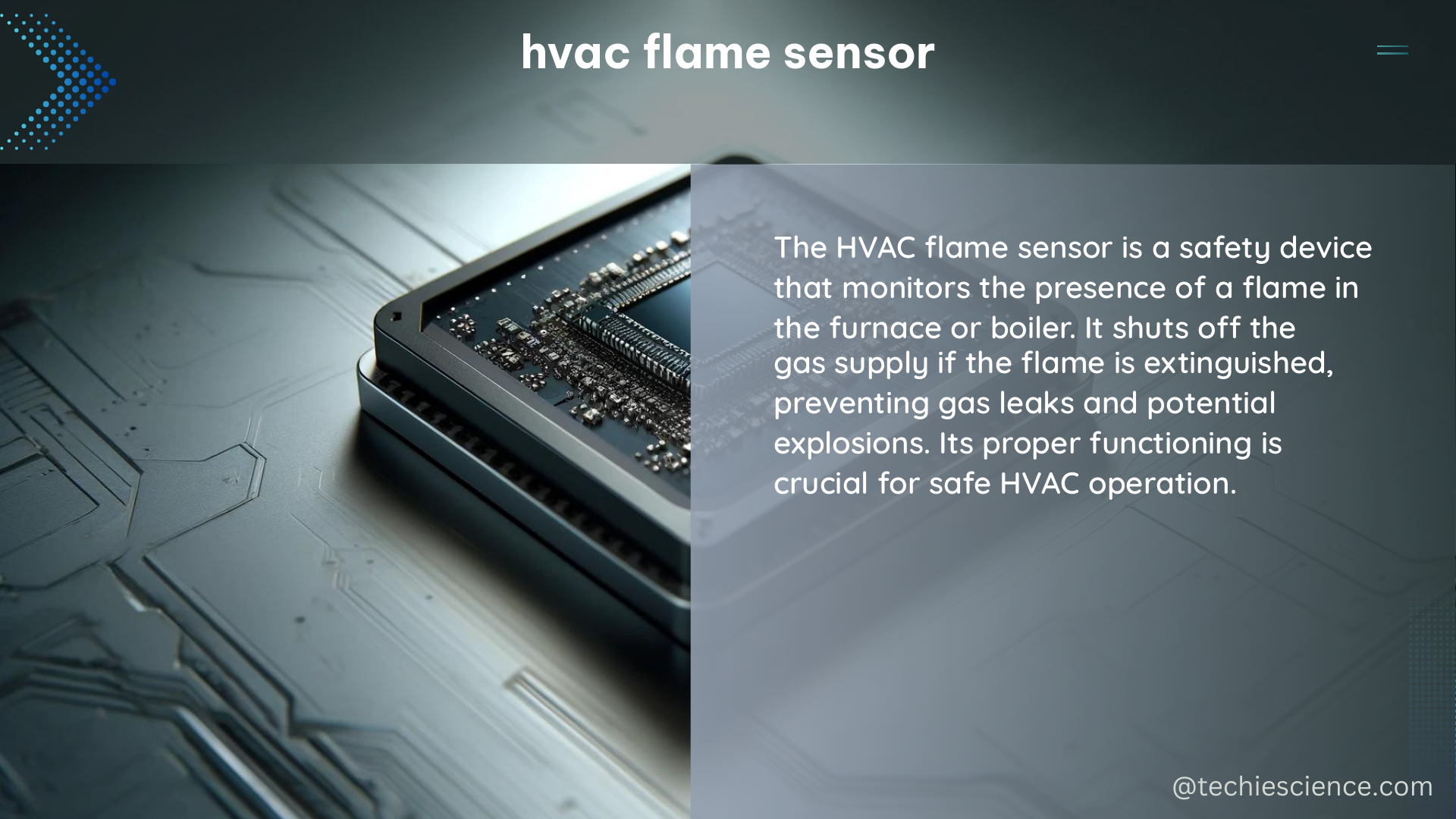The HVAC flame sensor is a critical component in gas heating systems, responsible for detecting the presence of a flame and ensuring the safe operation of the system. This sensor works by rectifying a low AC voltage to a DC voltage when inserted into a proper flame, which then converts to a measurable micro-amp current signal. This flame signal is used by the control board to determine if the burners are firing correctly and to shut off the gas supply if the flame is not detected.
Understanding the Flame Sensor
The HVAC flame sensor is typically made of a metal rod or probe that is positioned in the path of the burner flame. When the flame is present, it heats the sensor, causing it to generate a small electrical current. This current is then measured by the control board, which uses it to determine if the burner is lit and functioning properly.
The flame sensor works on the principle of flame rectification, which is the ability of a flame to conduct electricity. When the flame is present, it creates a conductive path between the sensor and the ground, allowing a small amount of current to flow. This current is then measured by the control board and used to determine the status of the burner.
Measuring the Flame Signal

To measure the flame signal, a multimeter capable of measuring micro-amps (μA) must be used. The meter should be connected in series between the flame sensor and the wire connected to it. A clean flame sensor should measure between 4 to 6 μA, while a dirty or failing sensor may measure below this range.
When testing the flame sensor, it is important to ensure that the furnace is properly grounded and that the polarity is correct. The flame sensor should be positioned so that it is fully covered by the flame, and the meter should have a resolution of at least 0.10 μA for accurate readings.
The leads of the meter should be connected in series, with one lead connected to the flame sensor and the other connected to the terminal on the control board. A proper microamp reading should be between 0.5 and 10 μA, depending on the specific furnace model.
Cleaning and Maintaining the Flame Sensor
Regular cleaning and maintenance of the flame sensor is essential for proper function. Over time, the sensor can become coated with soot, dust, or other debris, which can reduce its ability to detect the flame and generate a proper signal.
To clean the flame sensor, use a 3M Scotchbrite pad or a similar non-abrasive material. Avoid using sandpaper or other abrasive materials, as these can damage the sensor’s coating and reduce its effectiveness.
When cleaning the sensor, be sure to disconnect the power to the furnace and allow the sensor to cool completely before handling it. Gently wipe the sensor with the Scotchbrite pad, taking care not to bend or damage the metal rod.
After cleaning, it is important to test the flame sensor to ensure that it is functioning properly. Use a multimeter to measure the microamp signal, and compare the reading to the manufacturer’s specifications. If the sensor is still not generating a proper signal, it may need to be replaced.
Troubleshooting Common Issues
If the flame sensor is not functioning properly, there are several common issues that may be the cause:
-
Dirty or Damaged Sensor: As mentioned earlier, a dirty or damaged flame sensor can prevent it from generating a proper signal. Clean the sensor and test it again.
-
Incorrect Sensor Positioning: The flame sensor must be positioned so that it is fully covered by the burner flame. If the sensor is not positioned correctly, it may not be able to detect the flame.
-
Faulty Wiring or Connections: Check the wiring and connections between the flame sensor and the control board to ensure that they are secure and free of damage.
-
Improper Grounding: The furnace must be properly grounded for the flame sensor to function correctly. Check the grounding connections and ensure that they are secure.
-
Faulty Control Board: In some cases, the issue may be with the control board itself, rather than the flame sensor. If the sensor is functioning properly but the control board is not registering the signal, the control board may need to be replaced.
By understanding the principles of flame sensing and following best practices for cleaning and maintenance, HVAC technicians and DIY homeowners can ensure that their gas heating systems are operating safely and efficiently.
References:
- Deppmann. (2017-02-17). Measuring Flame Signal and Cleaning Flame Sensors | Deppmann. Retrieved from https://www.deppmann.com/blog/service-tip-of-the-month/measuring-flame-signal-cleaning-flame-sensors/
- HVAC-Talk. (2021-03-06). checking micro amps on flame sensor – HVAC-Talk. Retrieved from https://hvac-talk.com/vbb/threads/83745-checking-micro-amps-on-flame-sensor
- Testing Furnace Flame Sensor Before – YouTube. (2021-03-08). Retrieved from https://www.youtube.com/watch?v=9S024m0S0cA
- HVAC School. (n.d.). Flame Sensing – The Basics – HVAC School. Retrieved from https://www.hvacrschool.com/flame-sensing-the-basics/
- DoItYourself.com Community Forums. (2024-02-10). Gas furnace flame sensing – DoItYourself.com Community Forums. Retrieved from https://www.doityourself.com/forum/gas-oil-home-heating-furnaces/646556-gas-furnace-flame-sensing.html

The lambdageeks.com Core SME Team is a group of experienced subject matter experts from diverse scientific and technical fields including Physics, Chemistry, Technology,Electronics & Electrical Engineering, Automotive, Mechanical Engineering. Our team collaborates to create high-quality, well-researched articles on a wide range of science and technology topics for the lambdageeks.com website.
All Our Senior SME are having more than 7 Years of experience in the respective fields . They are either Working Industry Professionals or assocaited With different Universities. Refer Our Authors Page to get to know About our Core SMEs.